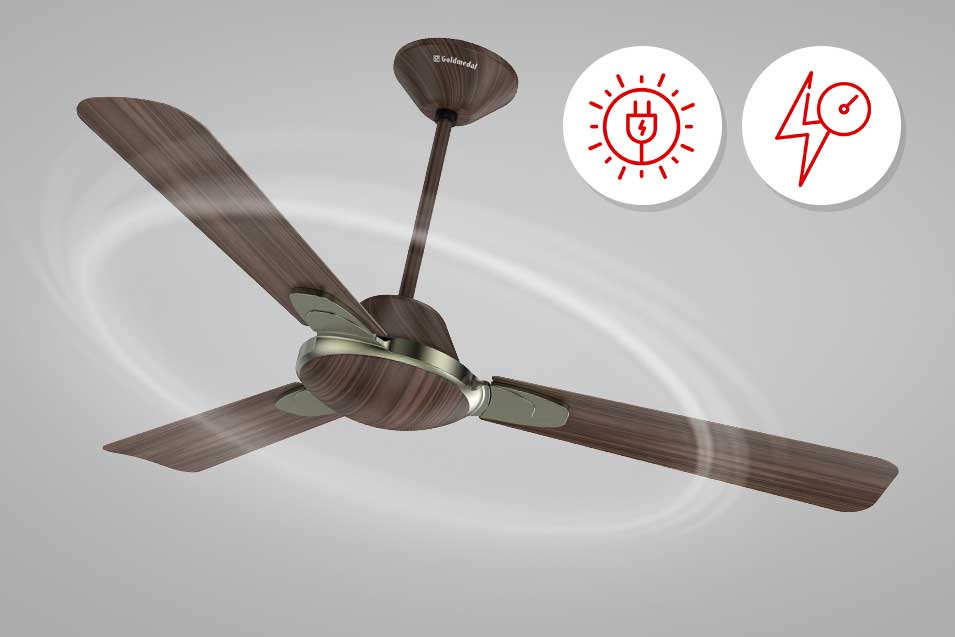
Understanding Ceiling Fan Power Consumption: Tips for Energy Efficiency
Ceiling fans are a staple in most Indian homes, providing comfort and relief from the sweltering heat. But have you ever wondered about their power consumption and how to make your ceiling fan more energy-efficient? In this blog post, we’ll explore the ins and outs of ceiling fan power consumption and provide tips for maximising energy efficiency.
How Does Power Consumption Work for Ceiling Fans?
A ceiling fan uses approximately 75 Watts of electricity and it varies depending on several factors:
Fan Size: Larger fans typically consume more power than smaller ones.
Fan Speed: Running your fan at higher speeds will use more energy.
Fan Motor Efficiency: High-quality, efficient motors consume less energy.
Lighting: If your fan has built-in lights, they will also add to the power consumption.
Ceiling Fan Wattage Based on their Size:
| Size | Wattage |
|---|---|
| 30-inch | 42 |
| 36-inch | 55 |
| 42-inch | 65 |
| 48-inch | 75 |
| 52-inch | 84 |
| 60-inch | 92 |
| 72-inch | 100 |
Tips for Energy Efficiency in a Fan:
Now that you understand the basics of power consumption, let’s explore some tips for optimising your ceiling fan’s energy efficiency:
- Choose the Right Size Fan: Select a fan size appropriate for the room. Oversized fans can lead to unnecessary energy consumption. You may refer to our blog on How to select the right sized ceiling fan for your space to know more.
- Use the Right Fan Speed: Adjust the fan speed to your comfort level. Lower speeds use less energy.
- Upgrade to Energy-Efficient Models: Consider investing in ceiling fans with ENERGY STAR certification or those equipped with DC motors for improved efficiency.
- Proper Maintenance: Regularly clean your fan blades and motor to ensure they operate at peak efficiency.
- Use Ceiling Fans in Conjunction with Air Conditioning:Ceiling fans can help distribute cool air from your AC more effectively, allowing you to set the thermostat a few degrees higher.
- Invest in LED Lighting:If your fan has built-in lights, opt for energy-efficient LED bulbs.
How to calculate your Ceiling Power Consumption?
Most ceiling fans in residential settings typically have a power rating (wattage) in the range of 50 to 100 watts. Here’s how you can calculate the power consumption per hour:
- Find the Wattage: Check the fan’s label or user manual to determine its wattage. Let’s say your ceiling fan is rated at 75 watts.
- Determine the Speed: Ceiling fans often have different speed settings. The power consumption can vary based on the speed setting. If your fan is running at its highest speed, use that wattage. If it’s running at a lower speed, adjust accordingly. Approximate values can be like this:
Speed 1 2 3 5 5 Wattage 14 W 26 W 39 W 48 W 76 W - Calculate Usage Hours: Determine how long the fan is running in hours. For example, if the fan is on for 4 hours, use 4 in this calculation.
- Calculate the Energy Consumption: Multiply the wattage of the fan by the number of hours it runs. For example, if your fan is 75 watts and runs for 4 hours, the calculation would be:
Energy Consumption (in watt-hours) = Wattage × Hours
Energy Consumption = 75 watts × 4 hours = 300 watt-hours - Convert to Kilowatt-Hours (kWh): To get the energy consumption in kilowatt-hours, divide by 1,000 because 1 kilowatt-hour is equal to 1,000 watt-hours. In this case, it would be:
Energy Consumption (in kWh) = Energy Consumption (in watt-hours) / 1,000
Energy Consumption = 300 watt-hours / 1,000 = 0.3 kWh
So, if your 75-watt ceiling fan runs for 4 hours, it would consume 0.3 kilowatt-hours of electricity in that time. You can then multiply this by your electricity rate to determine the cost of running the fan for that duration.
Factors Determining the Energy Efficiency of a Ceiling Fan
To understand the electricity consumption of a ceiling fan, it is essential to ascertain its wattage. Additionally, the prevailing electricity rates in India should be taken into account as the second factor when calculating the operating cost of a ceiling fan per hour, day, week, or month. It’s worth noting that traditional ceiling fans tend to draw a substantial amount of power. Opting for a fan with a 5-star BEE rating would help you save the electricity most.as it consumes around 50 watts at maximum speed.
Conclusion:
Understanding ceiling fan power consumption and adopting energy-efficient practices not only reduces your energy bills but also contributes to a greener environment. By following the tips mentioned in this blog, you can enjoy the comfort of your ceiling fan while minimising your energy footprint. Remember, making informed choices about your electrical appliances, including ceiling fans, is a small step towards a more energy-efficient home.
Frequently Asked Questions (FAQs) :
Q1. How can I determine the power consumption of my ceiling fan?
Look for the wattage rating on the fan or in the user manual. You can also use a watt metre to measure its actual consumption.
Q2. Is it more energy-efficient to use a ceiling fan or an air conditioner?
Ceiling fans are generally more energy-efficient when used in conjunction with an air conditioner. They help distribute cool air, allowing you to set your thermostat higher and reduce AC usage.
Q3. What is the significance of ENERGY STAR-rated / BEE-rated ceiling fans?
These fans meet strict energy efficiency guidelines. They are designed to use less energy while providing optimal performance.Fans with a 5-star BEE rating would help you reduce your electricity consumption by around 30%-50%.
Q4. How many units of electricity are consumed by fans per day?
A typical ceiling fan typically utilises around 75 watts of electricity, though this figure can fluctuate based on factors such as the fan’s brand, size, and various other variables.

